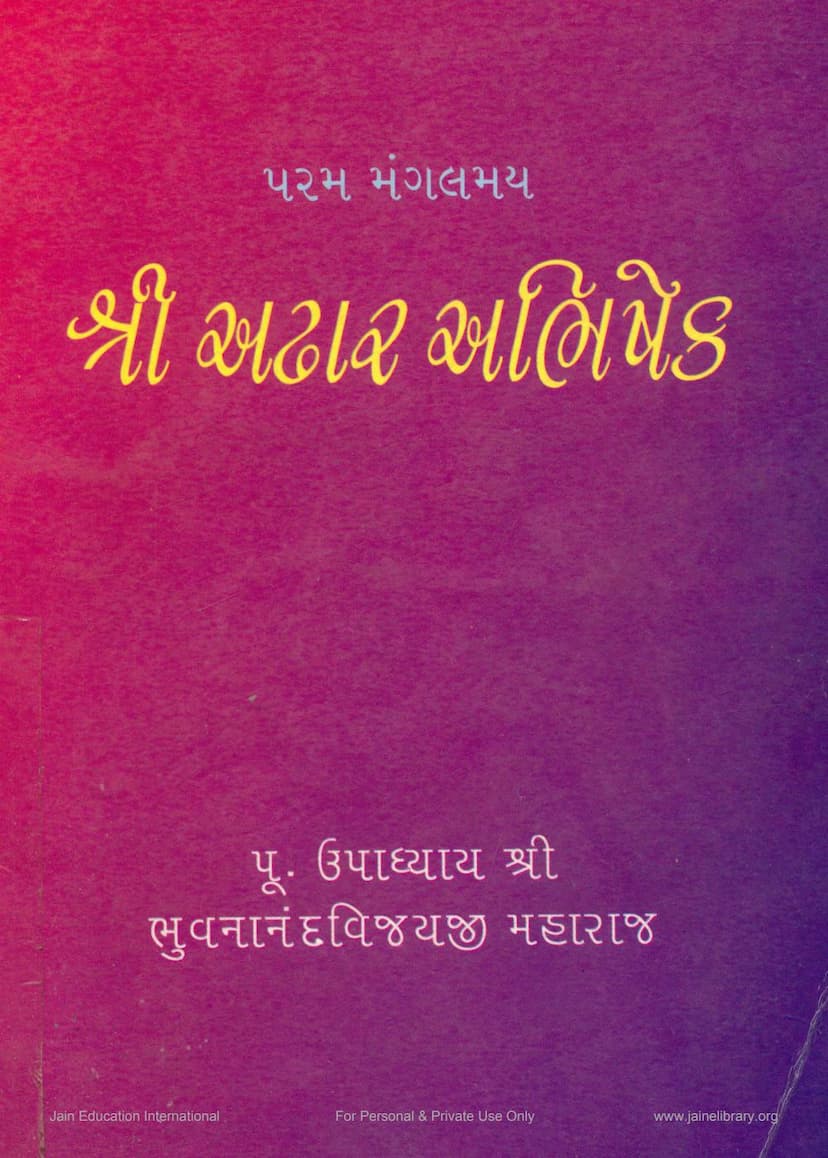Adhar Abhishek
Added to library: September 1, 2025

Summary
Here's a comprehensive summary of the Jain text "Adhar Abhishek" by Bhuvananandvijay, based on the provided pages:
Book Title: Param Mangalamay Shri Adhar Abhishek (The Supreme Auspicious Eighteenfold Ablution)
Author: Pujya Upadhyay Shri Bhuvananandvijayji Maharaj
Publisher: Shri Parshva-Padmavati Tirth, Vaktapur
Overview:
"Adhar Abhishek" is a Jain religious text that meticulously details the ritual of the "Eighteenfold Ablution." This elaborate ceremony, considered highly sacred and mentally uplifting, is performed in Jain temples on various auspicious occasions and to rectify specific shortcomings.
Key Themes and Purposes of Adhar Abhishek:
- Rectification of Transgressions: The text emphasizes that Adhar Abhishek is particularly recommended when any minor or major transgression (āshātana) has occurred in the temple, or when there has been an unintentional mistake or impurity. It is believed to cleanse these faults.
- Purification and Prosperity: Performing this ablution is said to remove various troubles and disturbances within the Jain community (sangha). It is seen as a way to invoke blessings and ensure well-being.
- Connection to Divine Auspiciousness: The ritual is performed during significant events like temple consecrations (pratishtha), consecration ceremonies (anjanashalaka), and various festivals and rituals like Shanti Snatra.
- Symbolic Representation: The eighteen types of ablutions use a variety of pure and sanctifying substances, mirroring the divine ablutions performed by celestial beings (Indras) and celestial maidens (Dikumarikas) for the Tirthankaras. It's a way for devotees to experience a glimpse of that divine ritual within their capacity.
Content and Structure:
The book is a compilation, with Upadhyay Bhuvananandvijayji Maharaj credited as the compiler, inspired by his spiritual teacher, Acharya Bhagwant Shrimad Vijay Anandghansurishwarji Maharaj.
The text outlines the following key aspects:
- Introduction and Purpose: The preface and introductory sections explain the significance of Adhar Abhishek, its traditional context, and the motivation behind compiling this book – the need for a systematic and accessible guide.
- Materials Used: The ablutions primarily involve natural substances like plants and their derivatives. Other ingredients like milk, curd, ghee, honey (though noted as absent in Jain Panchamrut), precious metals (gold, silver), fruits, grains, aromatic substances, and various types of medicinal herbs and roots are used. The purity and sanctifying properties of these materials are highlighted.
- The Eighteen Ablutions (Snātras): The core of the book details each of the eighteen specific ablutions. Each ablution is described with:
- Key Ingredients: The primary substances used for that particular ablution.
- Preparation: How to prepare the mixture in a water pot (jalakundi).
- Recitation: Specific Sanskrit shlokas (verses) to be chanted before and during the pouring of the mixture.
- Mantras: Specific mantras to be recited while performing the actual ablution.
- Ritualistic Actions: The process of pouring the substance over the idol, followed by puja with tilak, flowers, incense, and lamps.
- Bell Ringing: The instruction to ring bells 27 times during the mantra recitation.
- Post-Ablution Rituals: Mention of optional devotional singing, music, and dance.
Specific Ablutions Detailed (Pages 11-33):
The book systematically describes the following eighteen ablutions:
- Hiranyodak Snātra: Ablution with water mixed with gold.
- Pancharatna Snātra: Ablution with water mixed with five precious substances (pearls, gold, silver, coral, copper).
- Kashāya Snātra: Ablution with water mixed with various astringent plant extracts.
- Mangala Mruttika Snātra: Ablution with water mixed with sacred soils from significant locations.
- Sadaushadhi Snātra: Ablution with water mixed with pure medicinal herbs.
- Prathamāshtak-Varga Snātra: Ablution with water mixed with a group of eight specific herbs.
- Dwitiyāshtak-Varga Snātra: Ablution with water mixed with another group of eight specific herbs.
- Sarvaushadhi Snātra: Ablution with water mixed with a comprehensive array of medicinal herbs and aromatic substances.
- Mudradarshen Vidhan (Ritual of Displaying Mudras): A special ritual performed before the next set of ablutions, involving the spiritual leader invoking the deities using specific hand gestures (mudras). This is followed by a specific mantra and showering of rice grains (vasakshep) while a cymbal (dhanko) is played.
- Panchamrit Snātra: Ablution with Panchamrut (milk, curd, ghee, sugar, and sadly, a note is made that honey is not used in Jain tradition, so medicinal herbs are used instead).
- Sugandhshadhi Snātra: Ablution with water mixed with aromatic herbs.
- Pushpa Snātra: Ablution with water mixed with fragrant flowers.
- Gandha Snātra: Ablution with water mixed with fragrant substances like saffron, camphor, musk, agar, and sandalwood.
- Vasa Snātra: Ablution with water mixed with fragrant essences and sandalwood.
- Chandan-Dugdha Snātra: Ablution with milk and sandalwood paste.
- Kesar-Sharkara Snātra: Ablution with saffron and sugar.
- Chandra-Surya Darshan Vidhan: Rituals for showing the moon and sun representations to the deities, involving specific mantras and bell ringing.
- Tirthodaka Snātra: Ablution with water from 108 holy pilgrimage sites.
- Karpura Snātra: Ablution with water mixed with camphor.
- Kesar-Chandan-Pushpa Snātra: Ablution with water mixed with saffron, sandalwood, and flowers.
Concluding Rituals:
After all eighteen ablutions are completed, the ritual concludes with:
- Kusumanjali: Offering flowers with a specific mantra and bell ringing.
- Ashtaprakari Puja: Performing the eightfold worship.
- Aarti: The ceremonial waving of lamps.
- Mangal Deep: Lighting of auspicious lamps.
- Shanti Kalash: Performing the ritual of the peace pot.
- Chaityavandan: Prostrations to the temple deities.
- Apology for Offenses: A final prayer seeking forgiveness for any unintentional mistakes during the ritual ("Avidhi Ashatana Michchhami Dukkaḍam").
Overall Significance:
"Adhar Abhishek" is presented as a vital ritual for the purification, protection, and spiritual well-being of the Jain community and its temples. The book serves as a practical guide, making this complex ritual accessible to devotees and religious officiants, and is dedicated to the spiritual lineage of the author's teachers.